Unsure about your French table manners? Click Here to download > > How to avoid these 10 food etiquette mistakes !
- Home ›
- Ze French ›
- La Gastronomie ›
- Weird French Foods
24 Weird French Foods We still love in France
Updated 03 August 2025 by Leyla Alyanak — Parisian by birth, Lyonnaise by adoption, historian by passion
Updated 03 August 2025 by Leyla Alyanak
Curious about what the French really eat behind the cheese and croissant clichés? From snails to sheep’s testicles, here are 24 weird French foods that might surprise you — and that many of us still love.
There are many stereotypes about the French, and quite a few center around this question; "What do the French eat?"
Weird French foods, that's what.
And the things we eat are not always gourmet, either. You'd be surprised to know this French cheese is one of the nation's most popular!
Yes, we do eat things that may seem like strange French food to you.
But to us, they are no stranger than other weird foods around the world: haggis in Scotland, Vegemite in Australia or root beer or deep-fried candy bars in the USA. We all enjoy dietary oddities to which we cling.
Why did I say we "still" love them?
Because our parents and grandparents used to eat them, and some have gone out of style (while others are making a comeback).
No one likes all foods, so obviously not everyone in France will like everything on this list. But every item will be loved by someone...
A word of warning: if you're vegetarian or vegan, this article is NOT for you! The same goes if you have a deep-seated aversion to offal...
What do people eat in France that you won't try? ever?
- 1. Snails (Escargots)
- 2. Frogs Legs (Cuisses de grenouille)
- 3. Sea Urchin (Oursin)
- 4. Foie Gras
- 5. Steak Tartare
- 6. Black or Blood Pudding (Boudin noir)
- 7. Rabbit (Lapin)
- 8. Chitterling Sausage (Andouillette)
- 9. La Vache Qui Rit
- 10. Whelks or sea snails (Bulots)
- 11. Pigs' Trotters (Pieds de porc)
- 12. Beef Tongue (Langue de boeuf)
- 13. Tripe (Tripes)
- 14. Brains (Cervelle)
- 15. Pike dumplings (Quenelles)
- 16. Smelly cheeses (Fromages puants)
Back to the food, and I should say there are some French "delicacies" that make even me (and plenty of French people) cringe. You'll find those further down this list.
But mostly, that supposedly disgusting food we are accused of eating is, actually, sublime. Go on, make the effort! (I've tried haggis, vegemite and root beer... and I'm still here...)
What do people eat in France that you won't try? Ever?
I've started this list of so-called weird French dishes with my favorite delicacies and worked my way down the ladder of bizarre food ickiness — so this is a personal and subjective list.
I have every faith you will disagree with my choices (and possibly run screaming before you finish reading this entire page).
1. Snails (Escargots: es-car-GO) sure to be on your list of strange French food
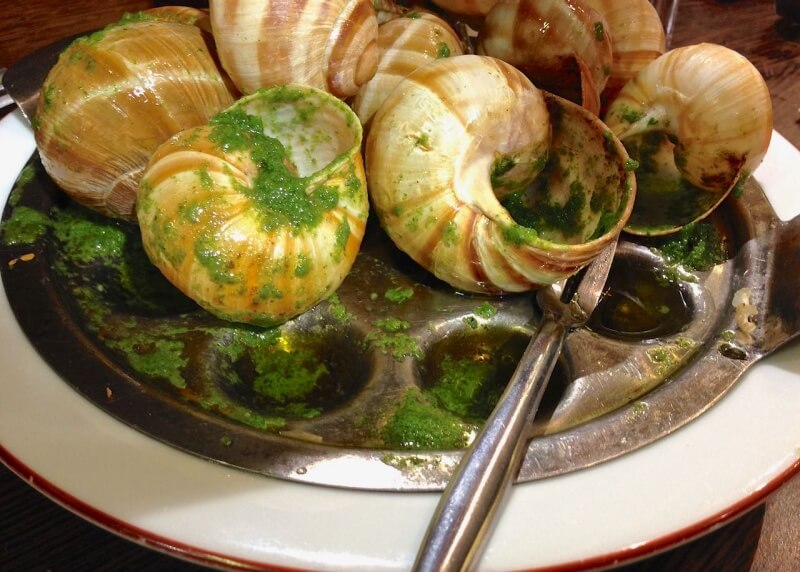
This little critter is much maligned but, I admit, one of the delicacies of France, at least in my humble opinion.
To those who think they are dirty or dangerous, the answer is No, at least not if you eat them from a reputable source. A properly prepared escargot is washed several times, purged, salted and boiled before it ever reaches your plate.
According to legend, the first escargots de Bourgogne, or Burgundy snails, as the best ones are known, appeared in 1814 during a visit to France by the Russian czar, Alexander I.
He was to dine with Talleyrand, Napoleon's chief diplomat, but they were running late and the restaurant – yes, it was in Burgundy – was out of food. The innkeeper had to think on his feet so he rushed out to the garden, where some snails caught his eye.
He quickly transformed them into a meat dish and voilà, a French delicacy was born. (Please don't follow his example: as I mentioned, there is plenty of preparation that goes into making an escargot ready for consumption.)
Yes, they do seem a bit icky, even to me, if I sit and think about them. So I don't. Instead I focus on the essentials: creamy butter, fresh parsley, and mounds (no, hills!) of fresh garlic.
In the end, these French snails are merely supports for the sauce. It wouldn't do to simply slurp butter so escargots help us pretend we're being civilized about all that butter, helped along by little broken chunks of baguette (normally one would avoid dipping bread into a sauce by hand but when it comes to escargots, everyone else will be too busy doing the same thing to look at you!)
I should add that our 'snail-eater' label is a little misplaced. We do eat them, and love them, but it's not an everyday dish and if you walk into a French restaurant for the first time, don't worry, no one is going to force half a dozen little snails upon you.
2. Frogs Legs (Cuisses de grenouille: kwees-duh-gruh-NOOee)
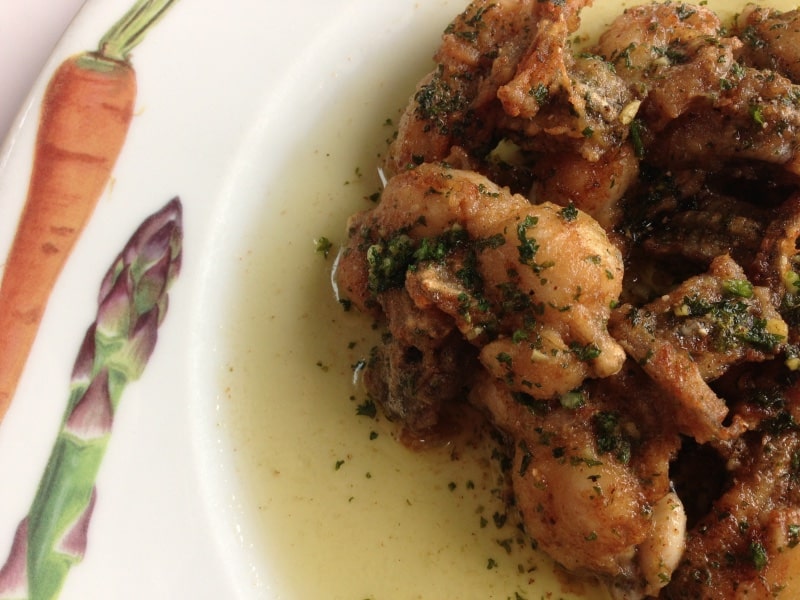
Along with escargots, many people believe frog legs are the most popular dish the French eat every day.
I know this falls under the banner of "weird French food" but wait... why is it any weirder than eating chicken or quail? The taste is certainly similar.
And frogs' legs aren't even French...
Originally they were eaten in China, around the first century BCE, and traces have been found in food stores belonging to the Aztecs, which would take us to the 13th century or so.
They only appeared in France during the Middle Ages, in monasteries, and fame followed when they were included in a cuisine dictionary written by Alexandre Dumas, of The Three Musketeers fame.
Now this is one of those interesting French foods you must sample in a top restaurant, not because they make them better, but because of the frogs they use.
In cheaper venues or at the supermarket, frogs' legs (usually frozen) come from Indonesia, where our appetite for them is threatening their survival.
In France, frogs are a protected species but there are farmed frogs, delicious and super expensive and usually only found in the best eateries. Alternatives are farmed frogs' legs from Turkey or Vietnam. Just stay away from the wild ones.
As for preparation, my favorite is — as with snails — butter, parsley and garlic (the more garlic the better), and lots of lemon. Some restaurants serve them breaded, or in a tomato sauce, but I'm a purist. Butter and garlic.
And by the way, this isn't a daily dish but one we have on special occasions or just once in a while.
3. Sea Urchin (Oursin: oor-SAN)
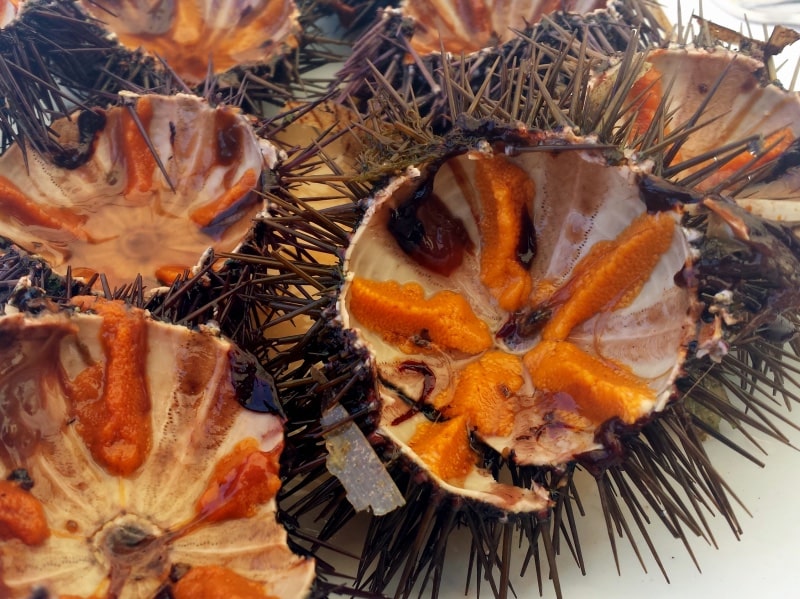
I'm not sure why these would be considered unusual foods: they're just normal seafood, albeit expensive and delicious. To me and thousands of others, this is a French delicacy. It can be an acquired taste, though.
But yes, oursins do look a little odd, what with all those little spikes, and they are extremely hard to open without physical injury. If you don't wear thick gloves, you will inevitably end up with a needle lodged in your skin — hence the need to eat these in a professional establishment that takes all those physical risks for you.
You can eat these like oysters, on the half shell, or experience the tender coral interior separately, mixed into a delicate sauce or scrambled with eggs, as you would do with caviar.
If you haven't tried these French food items, you MUST. Trust me on this one. We don't eat these often because of their cost, but when we do, we lick our fingers and wish for more.
4. Foie Gras (fwah-GRAH)
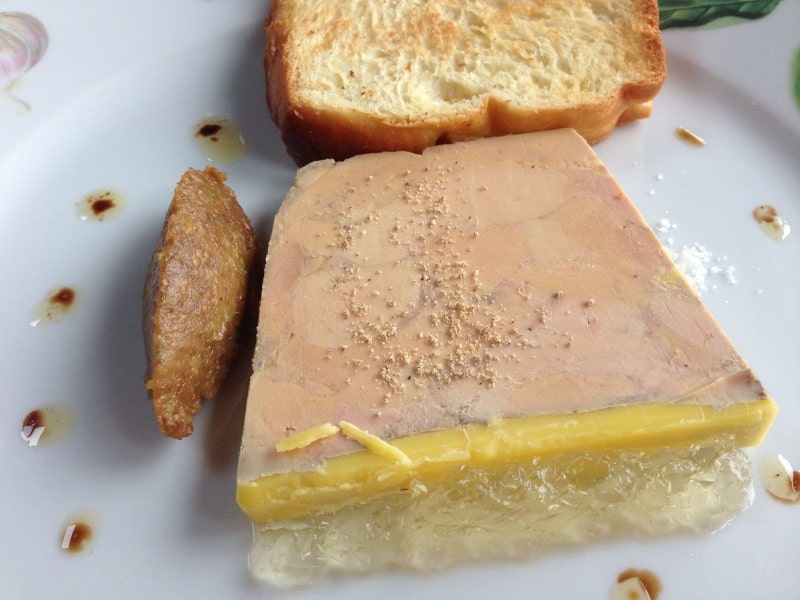
This staple of France food culture is the one that is probably most controversial, banned in some parts of the world (and increasingly, in corners of France itself): geese are force-fed to fatten their livers (foie gras actually means fatty liver), a practice that involves cruelty to animals.
Here we're only coming around to that kind of thinking but foie gras is such a popular food in France that eliminating it is almost unthinkable, at least for now.
Foie gras is incredibly popular, one of our most special French foods, and 93% of us eat it several times a year. It has been around as long as geese and ducks have been domesticated, their fat providing human consumption all year round.
In the beginning, our ancestors in the Middle East acquired a taste for natural foie gras, the kind the animals produced themselves and which they ate along with the rest of the goose or duck (both are popular). We can thank the Egyptians for discovering that geese gorged themselves before migration: they naturally produced foie gras to store fat for their long trip.
Eventually, these animals were domesticated and the Egyptians developed the art of fattening. This was built upon by the Greeks, Hebrews and, eventually, the inhabitants of Eastern Europe.
By the 17th century, the population of rural France was expanding quickly and in the southwest, geese and ducks increasingly became part of a household's wealth, hence the growth of the foie gras industry in this region (and in the East, too).
By the 19th century, villages were vying for the 'best foie gras' labels and markets began to specialize in this delicacy; some hugely reputable ones exist today: Brive, Périgueux and Sarlat, to mention just a few.
As thinking evolves and people become more conscious of animal welfare, farmers are looking for solutions because let's face it, asking the French to give up foie gras would probably be as successful as asking Germans to give up beer.
Several new methods have been developed that deliver foie gras without force feeding, but they remain experimental and expensive: a goose that is not force fed will need to be raised twice as long. Also, this alternative process means they cannot use the 'foie gras' label, which requires force feeding.
The challenge lies in finding these products, which remain rare. As for the price, until the new methods become mainstream, they will stay high. No matter. We'll just have to seriously cut back our foie gras consumption. Or eliminate it altogether. I'll be hunting for that alternative...
5. Steak Tartare (steak tar-TAR)
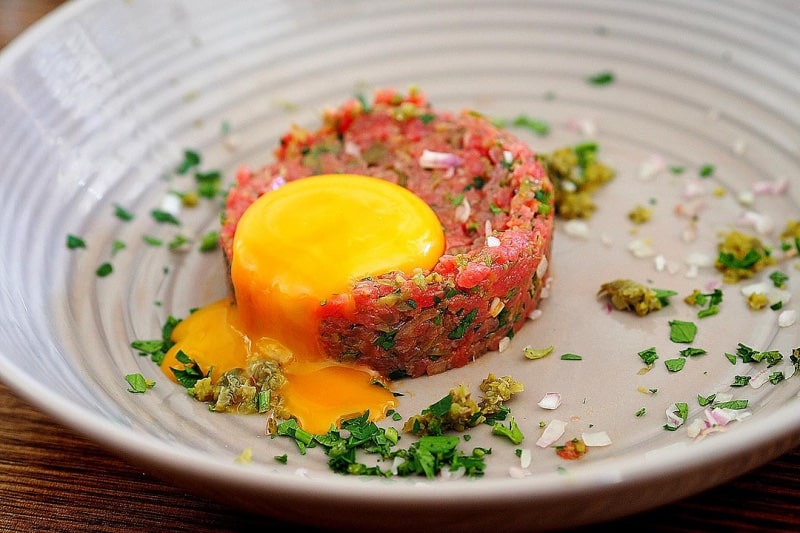 Classic Steak Tartare by insatiablemunch / CC BY 2.0
Classic Steak Tartare by insatiablemunch / CC BY 2.0There are so many jokes about tourists sending back their Steak Tartare because it was raw!
But this most delightful of French entrées is supposed to be raw: that's what Steak Tartare is, raw ground beef, flavored with a variety of additional seasonings (a selection of chopped onions, capers, mustard, Worcestershire sauce, hot sauce, a raw egg, salt, pepper...) Especially in summer, this is one of those France delicacies many of us can't go without.
Clearly the most important factor here is freshness (and meat quality, but that goes without saying). I would never buy a tartare from a supermarket or one that's packaged. I go to the butcher, pick my cut of meat, and have them grind it in front of me. Then I rush home, prepare it right away, and consume it within an hour or two.
Eating it out is also fun, usually in a brasserie. In the better establishment, the seasonings will be added in your presence, turning this traditional French food into a true gem.
It would seem that this delicacy originated among my own paternal ancestors, the Tatars of Central Asia. The wild hordes of the region rode on horseback, as you know, and to feed themselves during their travels, they may have placed a cut of salted meat, usually horse or camel, under their saddle for tenderizing and to rid it of excess blood. At mealtime, they would clean off the salt, grind the meat and eat it raw.
The "dish" slowly made its way westward through Russia into northern Germany, probably through the city of Hamburg, eventually reaching the shores of New York via immigration, to be known as Hamburg-style American fillet, or Hamburger Beefsteak. Sound familiar?
Yet its appearance as a France food is relatively recent, documented sporadically during the 19th century and firmly in the early years of the 20th.
At first it was known as American Steak, but the Steak Tartare appellation finally won over, used in France and also in the United States.
Let's Eat France! Part-cookbook and part culinary history, a pleasure to dip into if curiosity is your thing, whether about regional cuisine or about the quirks of a famous chef. You can't take it to bed with you - it's too big. Leave it on the table and curl up next to it. BUY ON AMAZON
6. Black or blood pudding (Boudin noir: boo-dan NWAR)
This is one of the relatively common French foods, eaten in France once the cooler weather comes around, often sautéed in butter with apples (at least that's how I eat it).
It is a delicious dish but granted, a round pile of black sausage isn't necessarily the most appetizing dish in the world. Not to sugarcoat it, but it is basically blood, with the addition of other ingredients, ranging from spices to fruits to rice.
But oh, it has such history! The boudin noir is probably the oldest charcuterie, or delicatessen meat, in the world, and you'll find it mentioned in Homer's Odyssey. Hunting societies have always battled with the issue of blood and what to do with it.
If you're British, this dish should seem familiar to you, since it is a traditional British breakfast food for some, isn't it? Black pudding?
In fact, there's hardly a country in Europe that doesn't have some sort of blood sausage among its specialties. Blutwurst in Germany, anyone?
By the way, this shouldn't be confused with the boudin blanc, which is pale in color and contains no blood, just meat and condiments.
7. Rabbit (Lapin: lah-PAN)
Some 80% of French eat rabbit, according to one survey, but that number is decreasing, mostly because rabbit meat is becoming hard to find, without anyone quite understanding how or why.
Perhaps rabbits are too large for today's smaller families, or perhaps it's because they are increasingly seen as pets.
That doesn't stop it from appearing on many restaurant menus, especially in western France, as a versatile dish – a terrine, or prepared with mustard or onions or prunes. I've only eaten it a few times in my life but each time, it has proven tender and delicious, a bit like a very good chicken.
But like many people, I have to forget what it looks like or I'll be pushing my dish away...
8. Chitterling sausage (Andouillette: on-doo-YET)
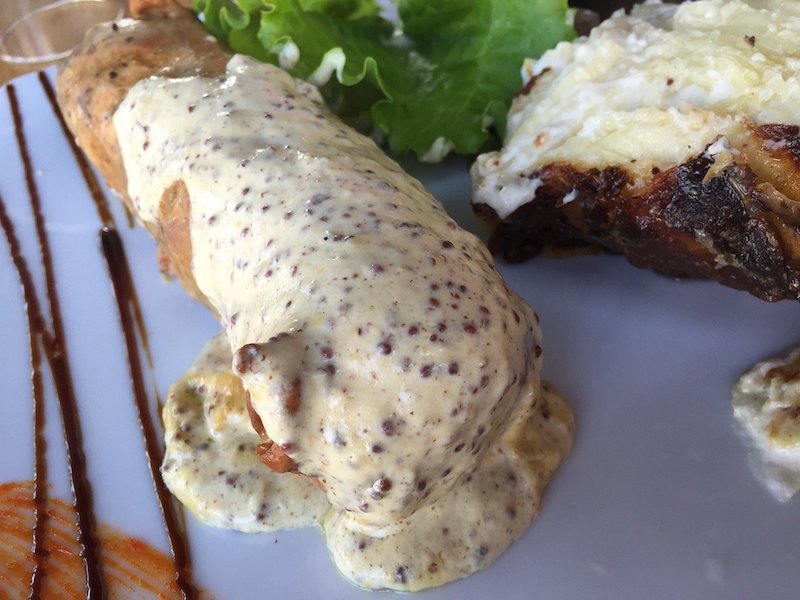
Now this is one of the often-disliked "weird foods" to try in France, at least by foreigners, and I can understand why.
First, the body part: it is made of pork intestines. And second, it smells quite strongly. But once these two obstacles overcome, a good andouillette is quite a treat.
It looks like a sausage, and is gently cooked in a frying pan. You then add a mustard-based cream sauce.
I'll travel quite far for a good andouillette. A poor quality one, on the other hand, can be a horrible experience so I'd suggest eating it in the kind of restaurant that specializes in it.
It is a speciality of many regions: anywhere that produces pork products is a good bet for andouillette, although in some regions it is also made of veal. There's even a grading system: AAAAA is the top quality andouillette. (Pronunciation: on - doo - YET).
To me, it is a main course I love and order each time I see it on a reputable menu!
9. La Vache Qui Rit (la-vash-kee-ree)

Depending on which survey you read, this is the most popular cheese in France, or one of the most popular, and is certainly up there among famous French foods.
I've included these famous La Vache Qui Rit cheese wedges under weird French foods because in a country reputed for its delectable cheese, the fact that a little triangle of soft cheese wrapped in foil makes the list is, in itself, a little odd.
Yet these are considered one of the top 10 most popular foods in the world. Yes, they're processed, but they nonetheless use the purest of French mountain cheeses – Comté and Emmental – along with a few foreign additions such as Gouda and Cheddar.
10. Whelks or sea snails (Bulots: boo-LOW)
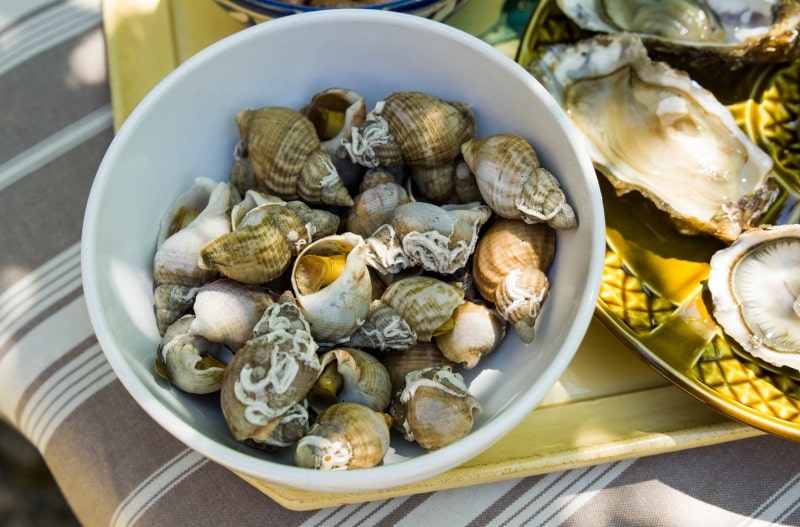
These may look a little like snails and in fact, they are snails, sort of sea snails, and like snails, they have to be boiled before being eaten.
Preparation for me takes away from the eating — I KNOW what they look like and I don't need to establish a close relationship with them before I eat them. I'd rather let the more skillful French chefs do that.
Some people like them with mayonnaise; I can't say I've ever tried them that way. Instead, they're usually part of a fresh seafood tray, tucked between a mound of oysters or clams. A squirt of lemon wouldn't be amiss...
11. Pigs' trotters (Pieds de porc: pee-YAY duh POR)
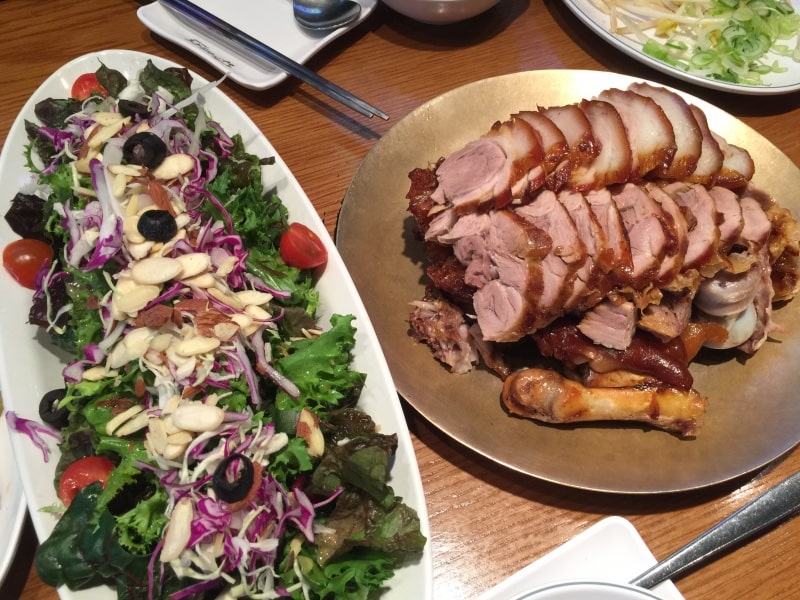
They're not called pigs' feet for nothing — because that's what they look like.
I could have sworn I'd never tasted them before. Not true. I did sample pigs' trotters in Seoul, jokbal, without knowing what they were. Properly camouflaged and cooked, and they were delicious.
I'm not sure I could cope with a recipe that serves them a little more au naturel, but used as pork in a variety of recipes, they are quite good.
In France, history tells us that in 1459, Charles VII stopped off in the village of Sainte-Menehould in northeastern France and was served the local version and loved the dish.
(Slightly) more recently, when Louis XVI fled Paris as the French Revolution was gearing up, it is said that he was recognized while eating these same pigs' trotters, in the same place, which is credited with elaborating a recipe so delicious they would melt in your mouth.
They're popular again, especially in the UK, as people search for less expensive cuts of meat that are nonetheless tasty.
12. Beef tongue (Langue de boeuf: long-duh-BUFF)
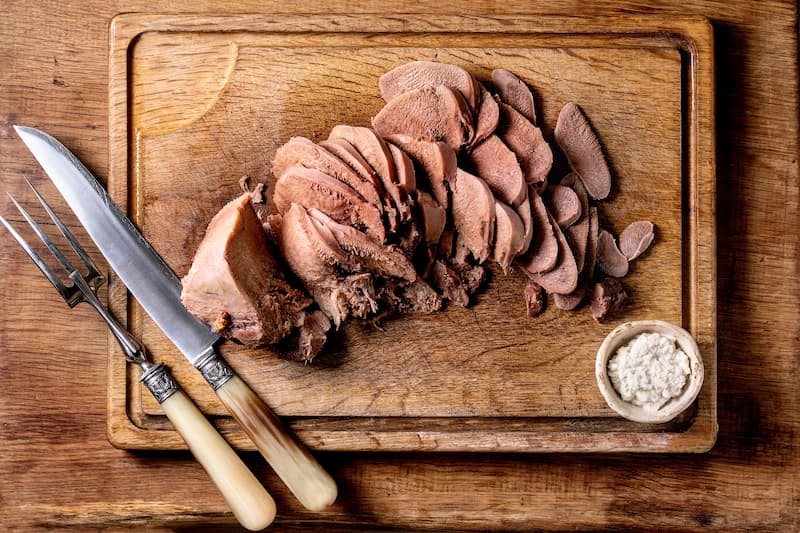
Yes, you guessed it, tongue of beef... the idea is not appetizing at all and this is one of those dishes you should taste once prepared but not look at beforehand, because it looks like... a tongue.
But the taste is, at least in my book, acceptable. It's not a dish I'll travel for or even choose on a menu, but I won't run screaming and can eat it if I have to. I'd just rather not.
This was apparently a much favored dish in Antiquity and gained in popularity during the Middle Ages.
Mostly it is served boiled, with one of several sauces, and is most popular in northern France, where offal is prized. Strangely (to my mind) beef tongue is more popular than calf's liver (which I love). But then, there's no accounting for taste...
13. Tripe (Tripes: treep)
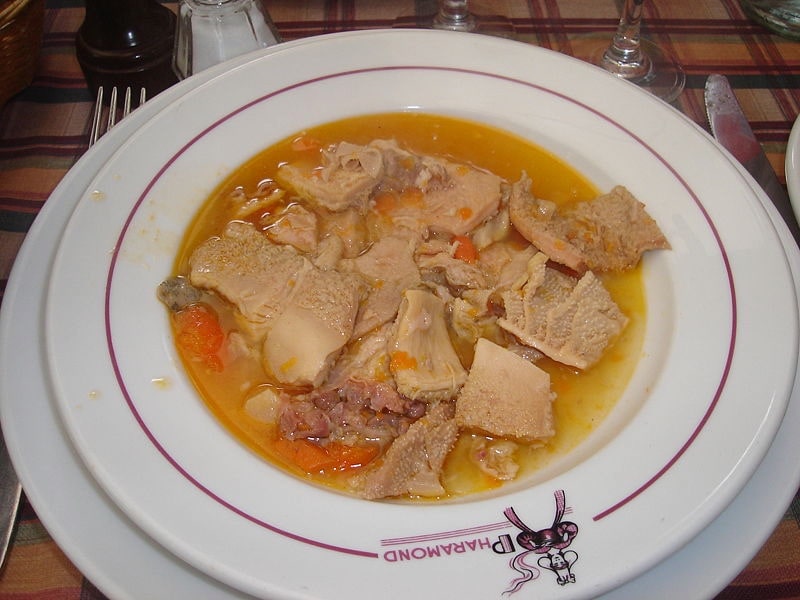 Tripes à la mode de Caen Yun Huang Yong / CC BY-SA
Tripes à la mode de Caen Yun Huang Yong / CC BY-SAWe're starting to move into less appetizing territory now, which some people might consider "nasty foods"...
The name says it all, and it's the same word in French and in English.
Some of my friends swear by this dish, which is made of the lining of an animal stomach, usually a cow. I, on the other hand, equate it with stuffing a gelatinous towel into my mouth. But you might love it.
This dish is most famous as tripes à la mode de Caen, or in the manner of Caen, a city in Normandy in northern France.
Tripes have an ancient history, much beloved by William the Conqueror, apparently, and possibly invented by his chef, somewhere during the 11th century.
Over the years tripe fell in and out of fashion, as recipes do. Its latest wave of popularity was after World War II and in some parts of France, you'll not only see it on every menu, but you'll hear howls of joy when it's spotted.
So please, don't let me influence you and make up your own mind. I've already made up mine.
14. Brains (Cervelle or Cerveaux: sayr-VELL or sayr-VOH)
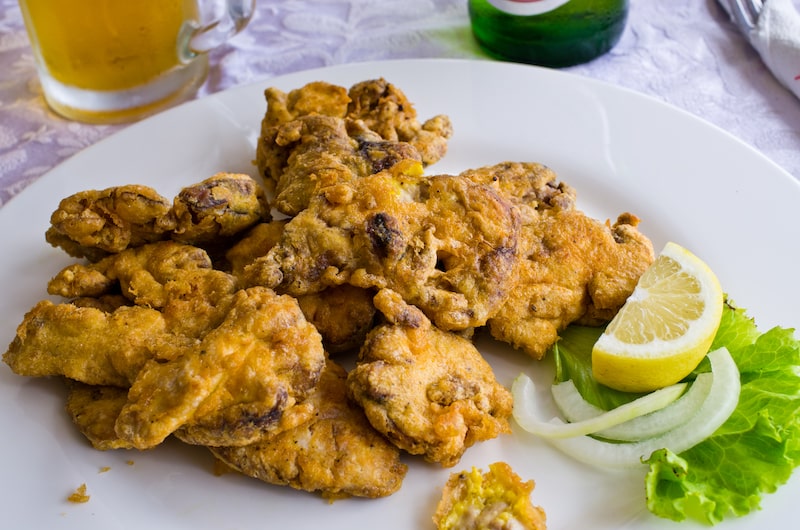
Like other offal – kidneys and tripe, for example – brains are losing popularity in France.
Lamb and mutton brains are the most popular and delicate, but they have to be exceedingly fresh.
They’re reputed to be good for your health, packed with vitamin B12 and phosphorous. But they won’t make you smarter.
As a child, I remember my mother frying them up, breaded, with lemon squirted on top, and it was always a treat.
Today, I probably wouldn’t buy them to cook at home but if I trusted the restaurant, I might order them. I do understand, though, that some people might consider this one of the more disgusting dishes around.
15. Pike dumplings (Quenelle de brochet: kuh-NELL duh bro-CHAY)
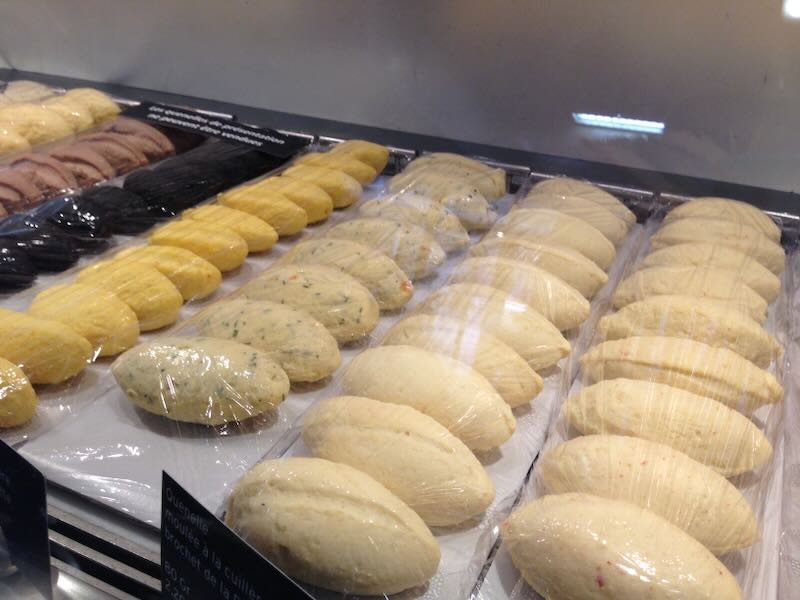
This isn’t really weird – but it’s different. Pike dumplings, shaped like an American football.
Their taste tends to be delicate, and they’re served with a crayfish sauce, Sauce Nantua. I mention it because it is typical of my region near the Jura mountains but not necessarily common everywhere else.
16. Smelly cheeses (Fromages puants: fro-MAHJ pew-ON)
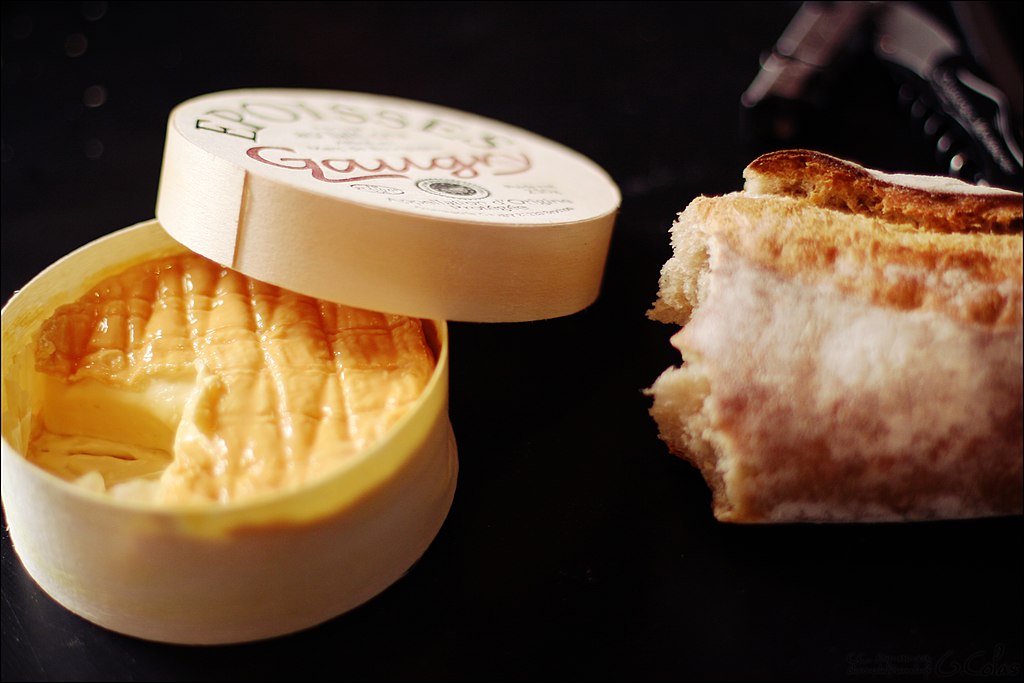 A delightful and smelly Epoisses. Photo Olivier Lemoine (https://Photo-Terroir.fr), CC BY-SA 4.0, via Wikimedia Commons
A delightful and smelly Epoisses. Photo Olivier Lemoine (https://Photo-Terroir.fr), CC BY-SA 4.0, via Wikimedia CommonsIf you’re accustomed to mozzarella or mild cheddar, France’s cheeses will indeed stun you with odor. Cheeses like Epoisses or Langres are renowned for their pungent aromas, even though their taste is often far milder than their smell.
These include such cheeses as Pont l’Evêque, Camembert or Munster, but not all of them. Each smells the most after a specific amount of refining, different for each one.
Why the smelly cheese?
During production, the bacteria and fungus are left to proliferate, giving the cheeses their powerful sour smell.
"The Medieval Kitchen is a delightful work in which historians Odile Redon, Françoise Sabban, and Silvano Serventi rescue from dark obscurity the glorious cuisine of the Middle Ages. Medieval gastronomy turns out to have been superb — a wonderful mélange of flavor, aroma, and color." BUY ON AMAZON
Even stranger french foods (which I haven't even tried)
17. Sweetbreads (Ris de veau: ree-duh-VO)
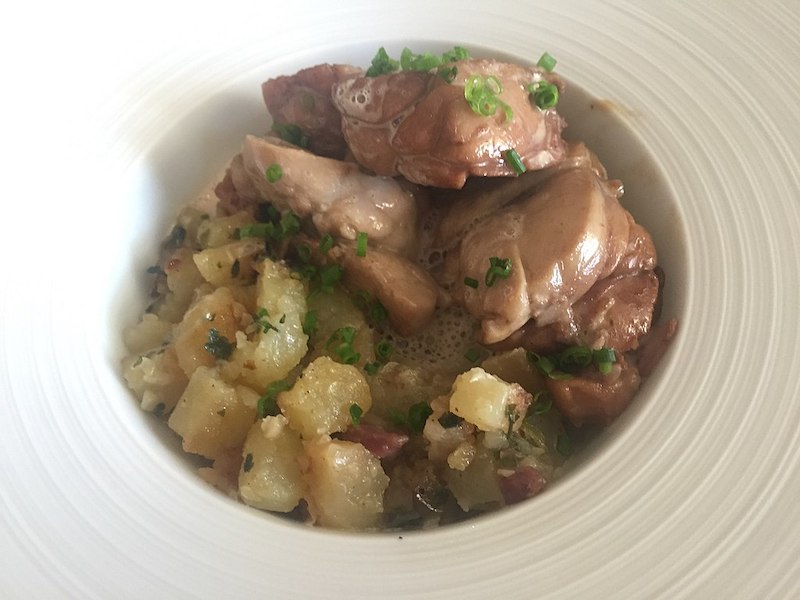 Sweetbreads, or Ris de veau. Photo Pierre LANNES, CC BY-SA 2.0, via Wikimedia Commons
Sweetbreads, or Ris de veau. Photo Pierre LANNES, CC BY-SA 2.0, via Wikimedia CommonsYou may know them as sweetbreads (also called the thymus or the pancreas, and if that doesn't stop you cold...)
This is a dish popular on several continents and it is particular loved in France, hard to prepare and rare enough on menus to be pounced upon the second it is spotted. It is often braised, served in a butter sauce or breaded and fried.
I'd like to tell you more about it but I've never tried it so I'll reserve judgment. Just know that I won't be moving heaven and earth to taste it.
18. Calf's head (Tête de veau: tet-duh-VO)
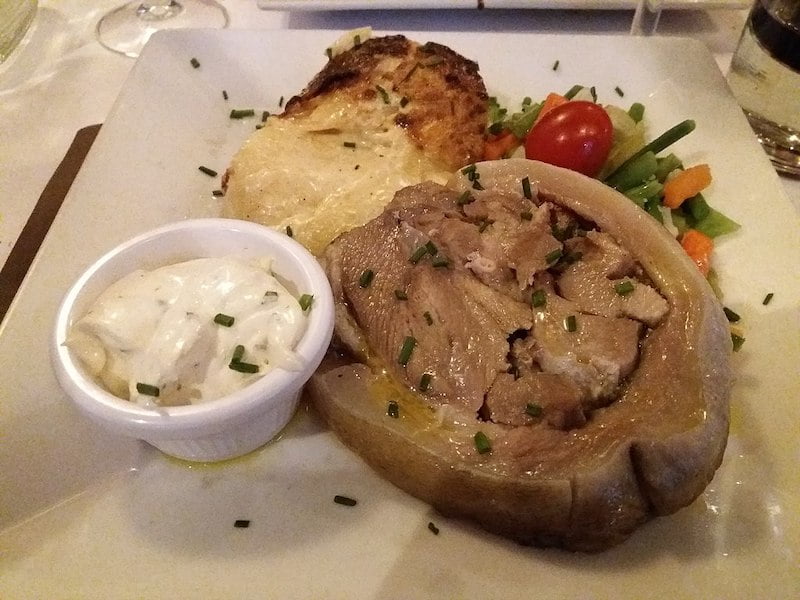
To me, the weirdest French food is calf's head, or tête de veau, and with that name it's no surprise I haven't tried this one either.
It can be served in several ways, most often in one of two ways, either deboned and rolled and tied with a string (this might be acceptable) or still boned, with the entire head presented at the table. No thank you, and if you want to call this one a "nasty food", go right ahead.
Yet this is a dish that generates plenty of loyalty in France, and several culinary brotherhoods and calf's head clubs each claim to hold the "authentic" and highest quality product. This dish gained traction when the late French President, Jacques Chirac, called it an "honorable dish" and said he would be happy to eat it often.
Each year, on 21 July, a calf's head meal commemorates Louis XVI's beheading, a tradition that dates back to the period of terror during the French Revolution, during which pigs' heads were used to symbolize the much-hated king. At some point, the pig morphed into a calf... So if you're looking for unique French foods, go no further.
19. Head cheese (Fromage de tête: fro-MAHJ-duh-tet)
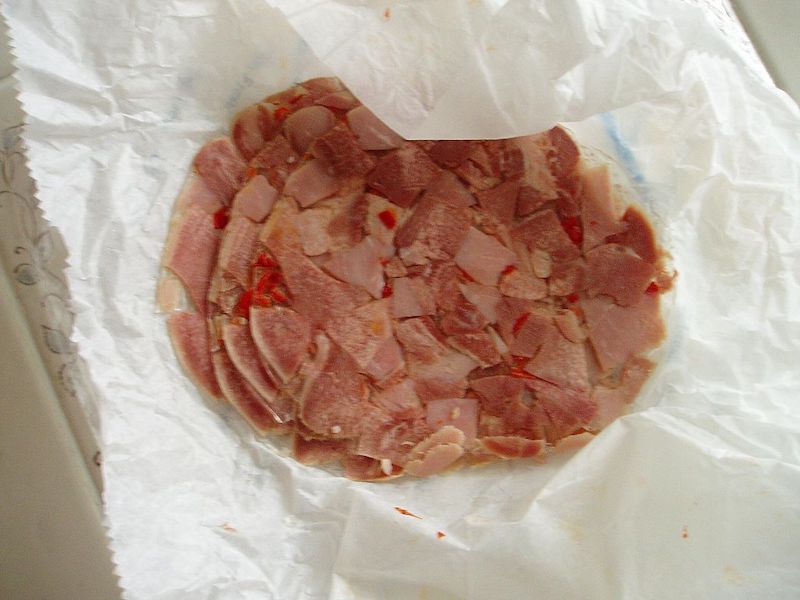
Made with pork or veal or wild boar, this dish is made with the animal’s head and tongue, a sort of pressed terrine or slice. Everything is boiled, and then pressed (like cheese, hence the name), and cooked with onions, carrots, turnips, white wine and herbs.
20. Horsemeat (Viande de cheval: vee-OND-duh-shuh-VAHL)
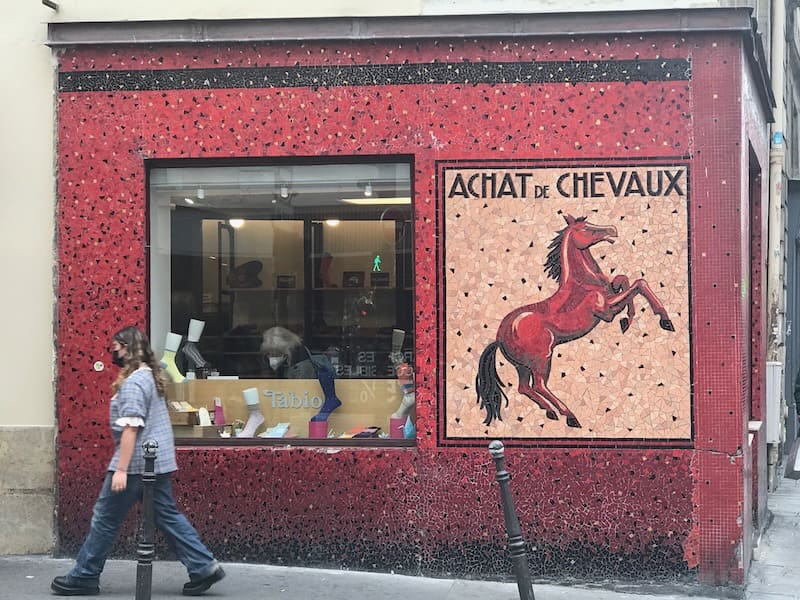 This shop in the Marais was once a butcher dedicated to horsemeat. It no longer sells meat but the sign was worth keeping ©OffbeatFrance
This shop in the Marais was once a butcher dedicated to horsemeat. It no longer sells meat but the sign was worth keeping ©OffbeatFranceFor years, horse meat was seen as a budget-friendly and healthy alternative to other red meats, and was considered more humane a death for the horse than being worked to death.
The advent of the automobile reduced the need – and therefore the supply – of horses so prices shot up and desire for what had often become a pet and a friend waned.
Horsemeat was sold in specialized butcher shops, but these days it can be sold anywhere meat is sold. I have it in my supermarket. But I’ve never tried it. Or if I have, it was accidental.
21. Sheep’s testicles (Couilles de mouton: cooey-duh-moo-TOH)
Couilles are testicles. Indeed, this part of the animal (sheep or lamb) is considered a delicacy far beyond France. I’ve tasted them in Spain but not here, mostly because they are a specialty of western France, in the Limousin region, across the country from me.
To cook, drain and boil, then slice thinly and sauté. Served with a bit of parsley and lemon.
Unlike some things on this list, these I would be willing to try.
22. Lamprey (Lamproie: lump-RWAH)
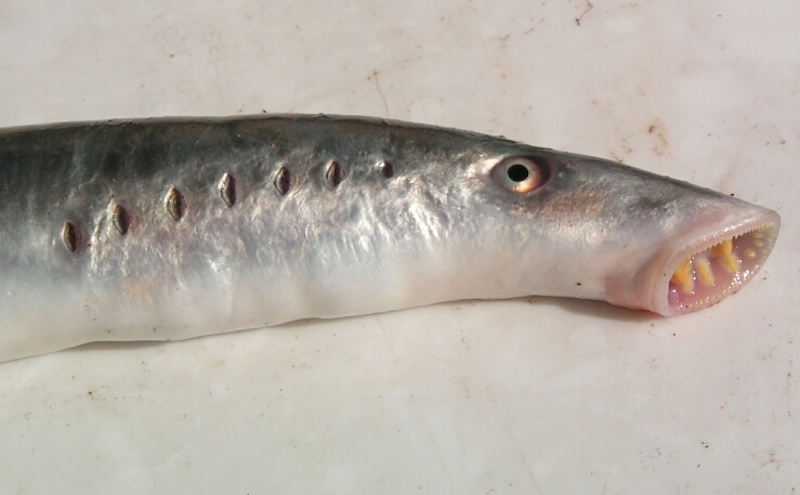
This particular dish is to be found in the Bordeaux region (and in case you don’t know lamprey, it’s an UGLY fish with teeth).
It’s a seasonal dish, with the fish caught in the Gironde River from Christmas until after Easter.
Basically it is a stew, with red wine, a local type of leek, onions and shallots, some garlic, and cured ham. And herbs, of course.
It is considered a delicacy and even has its own festival but frankly, one look at that face and any desire I might have had to taste it vanishes. It looks too much like a menacing snake…
23. Farci Poitevin (far-SEE pwah-tuh-VAN)
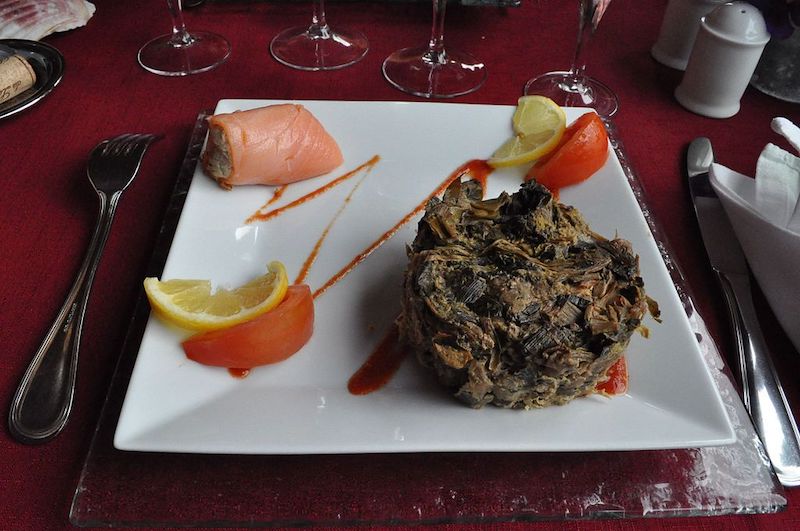
Farci means stuffed, and that’s what this is: a huge cabbage leaf stuffed with diced vegetables (and eggs and flour). Usually it is steamed or braised or baked in the oven – the leaf prevents all the other ingredients from falling out.
Often touted as vegetarian, I’ve seen quite a few recipes that incorporate lard, so beware.
24. Insects... (Insectes: an-SECT)
If you've ever walked down a Bangkok street, you've seen stalls with fried or roasted crickets, grasshoppers and any number of other insects. You may have been brave and tried them, or you may have rushed by quickly and averted your eyes (that was me).
Either way, insects have become fashionable as a protein source: they're cheap and they're abundant, they easy to raise, they don't contribute to climate change and farming them doesn't pollute. The World Food Programme has even suggested they might help solve the world's hunger problems.
That doesn't mean we have to like them...
In Europe, until now, selling insects as food has been illegal, although a few countries do sell whole insects for consumption within their borders.
But that isn't stopping the French from marketing what some see as the salvation of the planet and others simply call gross French food.
You can easily order such delicacies as onion-flavored crickets or whole crunchy insects with chillies online, and some companies offer such delicacies as insect-based burgers. These restaurants give them pride of place on their menus...
But no, I realize these aren't traditional foods but let's face it, they ARE weird.
Weird French foods FAQ
What is the French brain dish?
What is the French brain dish?
Veal brains, or cervelle de veau, usually fried or sautéed, with a butter sauce or a bit of lemon.
What are some controversial French dishes?
What are some controversial French dishes?
Foie gras, or duck or goose liver, made from force-feeding the animals.
What is unique French cuisine?
What is unique French cuisine?
Typical of French cuisine are the freshest produce, sauces, and plenty of butter, cream and cheese.
What are some of the things French eat but most other people wouldn't? Name a few.
What are some of the things French eat but most other people wouldn't? Name a few.
Actually, most unusual French foods are eaten in other countries as well. For example, snails are popular in Nigeria and Italy, and brains are common in South Asia and Turkey.
Before you go...
In the end, food is what we make it and different societies have evolved to eat and appreciate different things.
What you think of as weird French foods may be lifelong staples to us, whereas what you consider normal may raise an eyebrow or two at this end.
That said, what we call a typical breakfast in France might strike you as normal, so you see, we're not that different!
Did you enjoy this article? I'd love if you shared it!
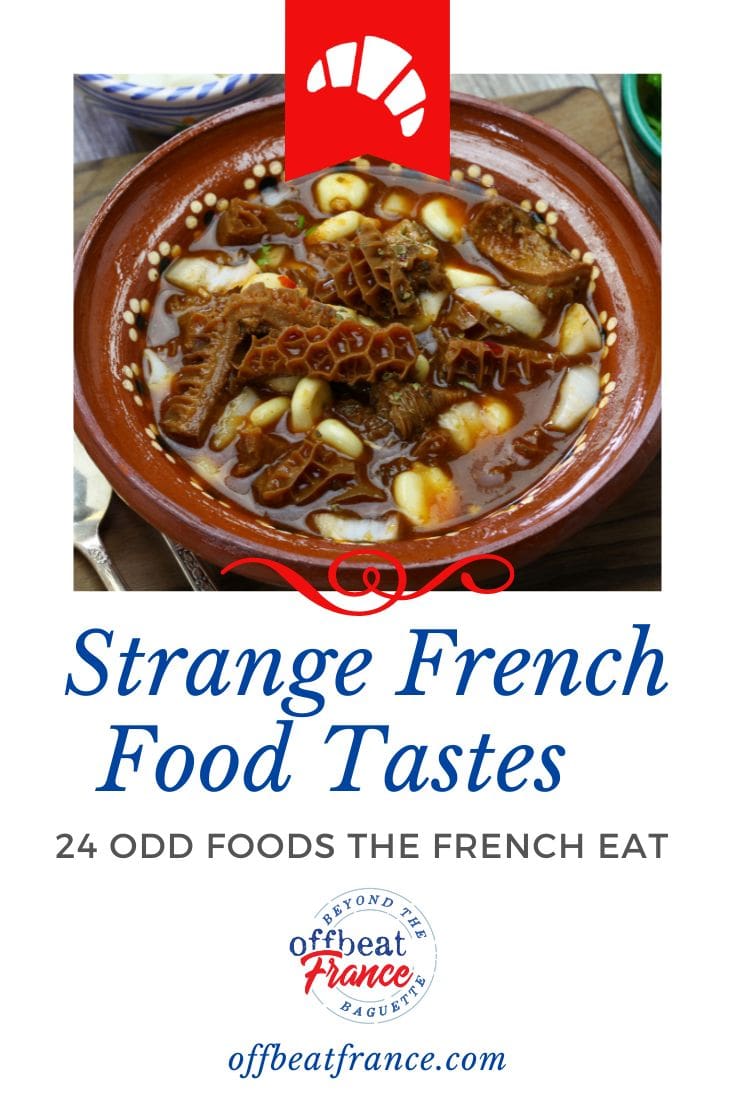 |
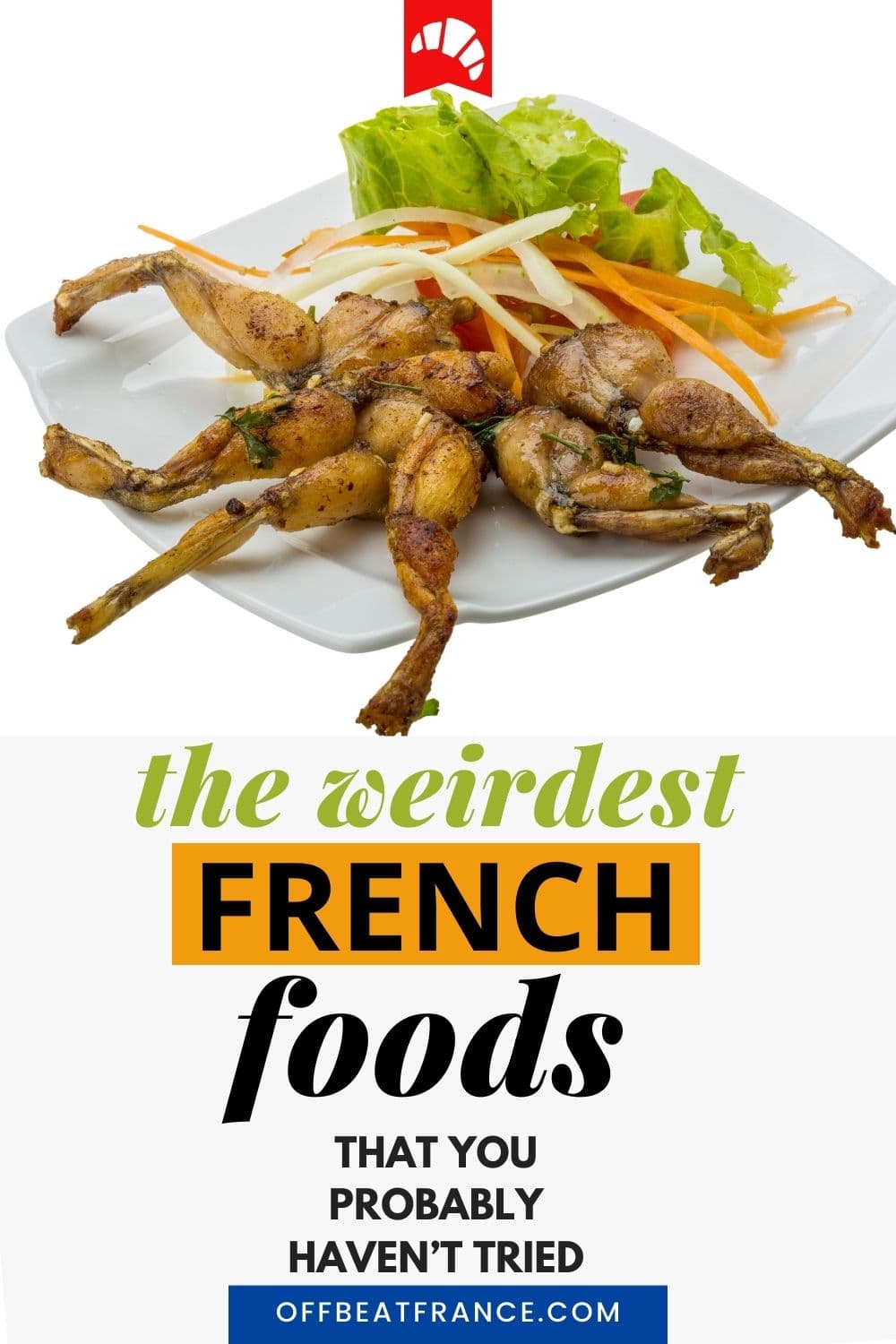 |
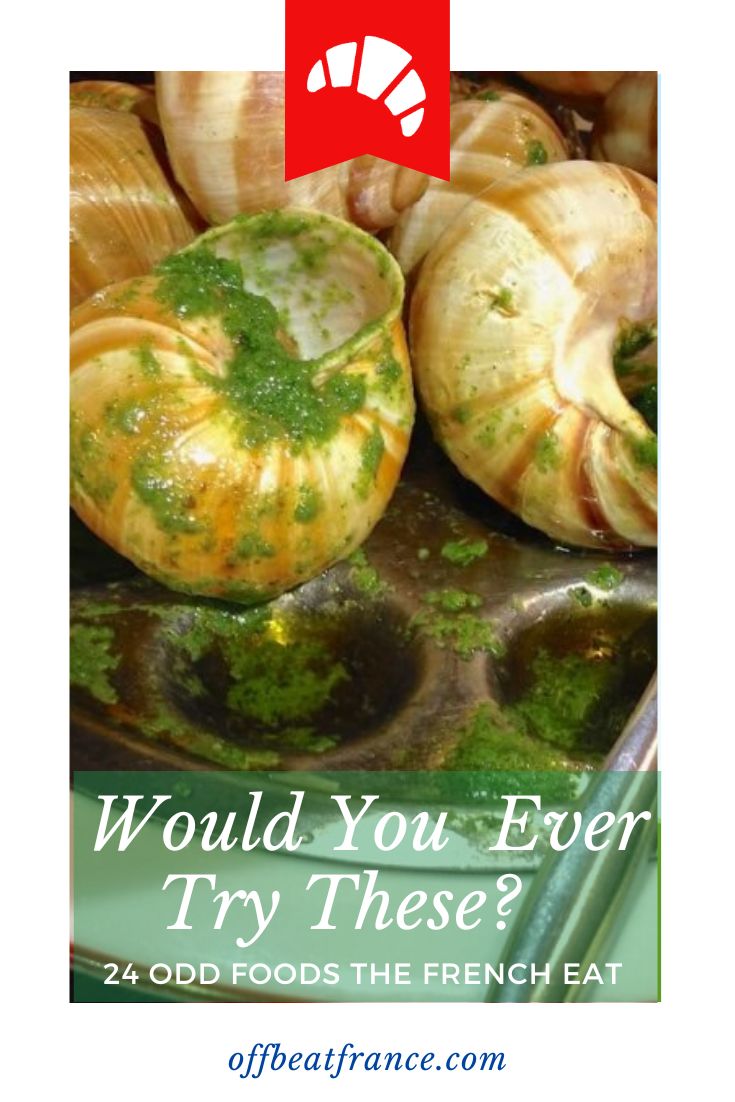 |

